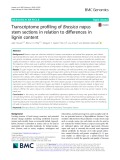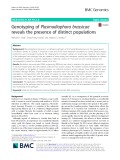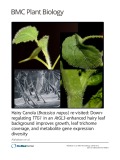
Canola productivity
-
Transcriptome profiling of Brassica napus stem sections in relation to differences in lignin content
Brassica crops are cultivated widely for human consumption and animal feed purposes, and oilseed rape/canola (Brassica napus and rapa) is the second most important oilseed worldwide. Because of its natural diversity and genetic complexity, genomics studies on oilseed rape will be a useful resource base to modify the quantity and quality of biomass in various crops, and therefore, should have a positive impact on lignocellulosic biofuel production.
 16p
16p  vibeauty
vibeauty
 23-10-2021
23-10-2021
 7
7
 0
0
 Download
Download
-
Plasmodiophora brassicae is a soilborne pathogen of the family Brassicaceae and the causal agent of clubroot disease. In Canada, P. brassicae is now one of the most important constraints to canola (Brassica napus) production, and is managed mainly by the deployment of resistant cultivars. In recent years, however, new strains of the pathogen have emerged that are capable of overcoming host resistance, posing new challenges for disease management. Despite its economic significance, molecular studies of P.
 10p
10p  vibeauty
vibeauty
 23-10-2021
23-10-2021
 9
9
 1
1
 Download
Download
-
Transition to flowering at the right time is critical for local adaptation and to maximize grain yield in crops. Canola is an important oilseed crop with extensive variation in flowering time among varieties. However, our understanding of underlying genes and their role in canola productivity is limited.
 18p
18p  visilicon2711
visilicon2711
 20-08-2021
20-08-2021
 13
13
 1
1
 Download
Download
-
Through evolution, some plants have developed natural resistance to insects by having hairs (trichomes) on leaves and other tissues. The hairy trait has been neglected in Brassica breeding programs, which mainly focus on disease resistance, yield, and overall crop productivity.
 25p
25p  vihashirama2711
vihashirama2711
 21-05-2020
21-05-2020
 13
13
 0
0
 Download
Download
-
Thus a study was designed to examine if significant levels of canola meal and DDGS can be used in market turkey diets and to determine which amino acids (tryptophan, isoleucine, arginine) may limit performance with diets containing canola and DDGS. Nicholas male poults were placed in starting pens at one day of age and reared to 5 weeks of age. Poults were fed a pre-experimental diet designed for best rate of gain. At 5 weeks of age the birds were randomly distributed into 98 pens with 10 birds per pen. Room temperature at 5 wks was...
 54p
54p  loginnhanh
loginnhanh
 22-04-2013
22-04-2013
 62
62
 5
5
 Download
Download
CHỦ ĐỀ BẠN MUỐN TÌM
















